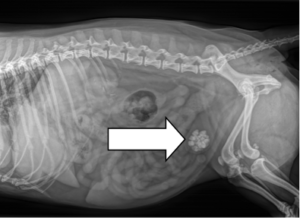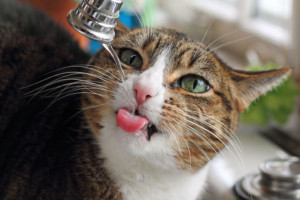Just like that, February is coming to a close. While we continue discussing topics of our pet’s health, did you know that February is actually National Cat Health Month? I think it’s time we officially celebrate this important month the right way, and just in the nick of time!
One very common health issue in cats is the development of bladder stones. Bladder stones pop up frequently in certain cats for many reasons ranging from genetics to an imbalanced diet. So, here is the 411 on bladder stones:
What in the heck are they? That’s a great question! Bladder stones are rock-like deposits of minerals, crystals, and organic matter found in a cat’s bladder (note, other species also get bladder stones). These deposits can remain small or can grow to rub against the bladder walls, causing inflammation. They can lead to blockage of the urethra, thus making it difficult and really painful for kitty to urinate.
Cats do wonky things all the time! How can we tell if their behavior is linked to bladder stones? Some of the symptoms to keep an eye out for are:
- Blood in the urine
- Painful urination
- Straining to urinate
- Frequent urination
*If you notice a sharp increase or decrease in your cat’s litter box output, keep a close eye on what they’re doing in there!
- Constant genital licking
- Chronic UTIs
- Urinary tract obstruction
- Urine spraying
- Urinating in unusual places
While a cat with stones may exhibit all or none of these symptoms, they are great markers for stones. If you notice any of these symptoms, or believe your cat may have stones, then usually x-rays, ultrasounds, and urinalysis/cultures will be necessary to confirm a diagnosis. It’s not only important to diagnose the existence of stones, but to figure out their cause so they can be prevented in the future.
It appears some cats are significantly more prone to bladder stones than others. This is because there are several contributing factors which can lead to bladder stones, and a single cat may even have more than one! A few of those factors include: a nutritionally imbalanced diet, decreased water intake, UTI, high concentration of certain minerals in the urine, specific PH of the urine, certain drugs and dietary supplements, congenital liver deformities, and breed disposition. For example, many vets state that persian and himalayan cats are specifically prone to bladder stones.
Just like the potential symptoms and causes, there is a variety of options to treat bladder stones. The choice really depends on the severity of the stones, and their cause. On an extreme level, cats with larger stones may require surgery to remove them. On the lesser end of the spectrum, stones can often be managed with a prescription diet which will dissolve the stones before they create a problem. Other options include increased water consumption (which is generally good practice for any cat), a flushing procedure to induce urination, or lithotripsy (breakdown of the stones with shock waves). Additionally, many cats simply pass the stones on their own!
So now you know! Bladder stones sound super scary, but they can be easily diagnosed and treated with the right knowledge and tools. It is always important to keep an eye on your cat’s elimination, pay close attention to any changes in their habits, and of course, provide a nutritionally balanced meal with plenty of fresh water. Remember, a healthy cat is a happy cat!







